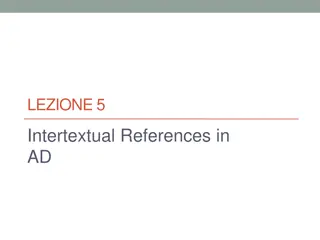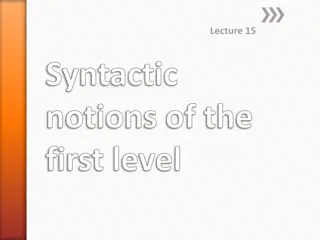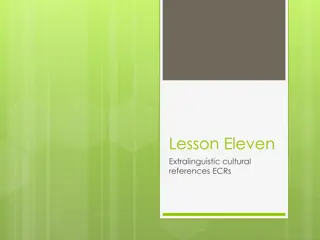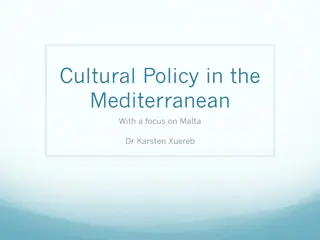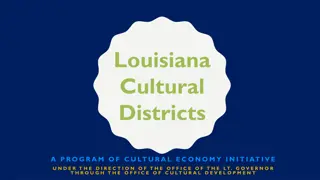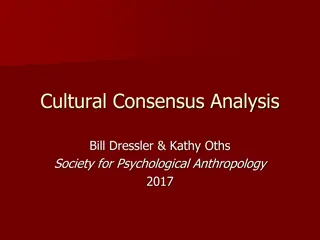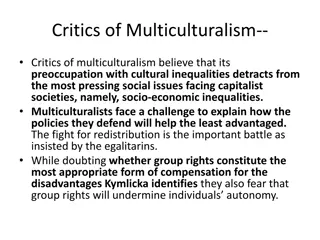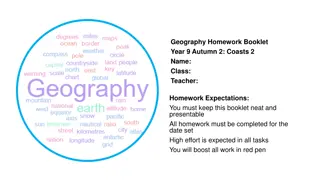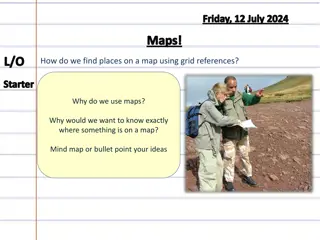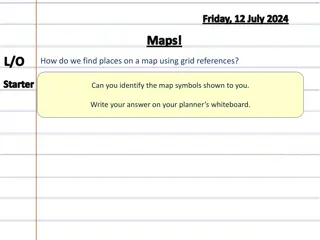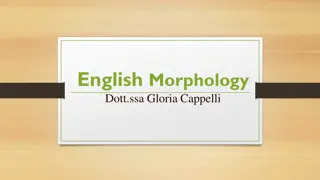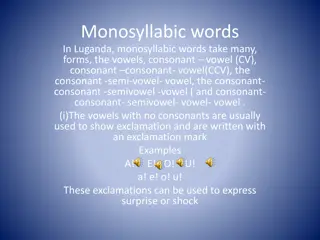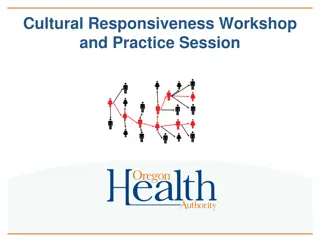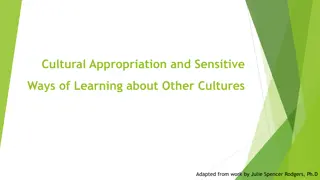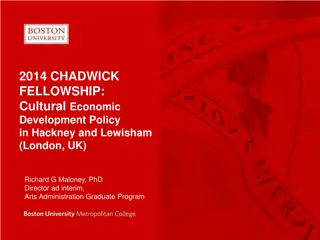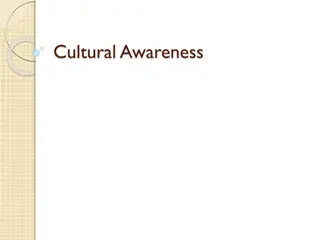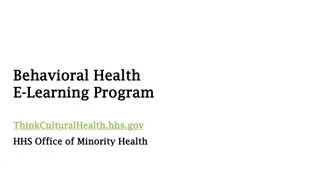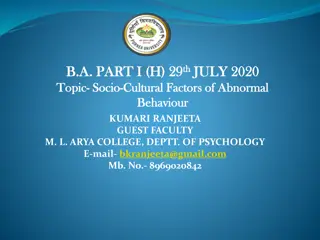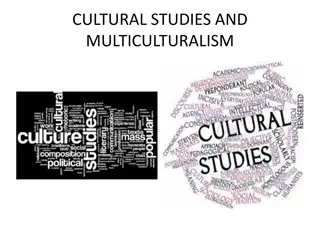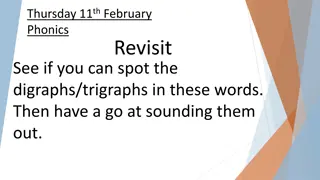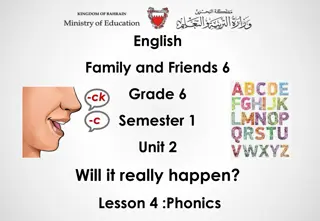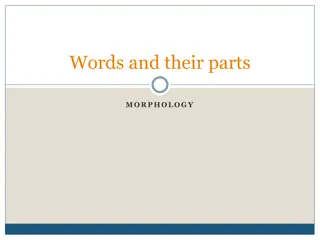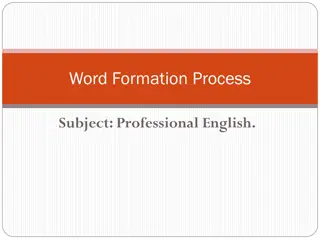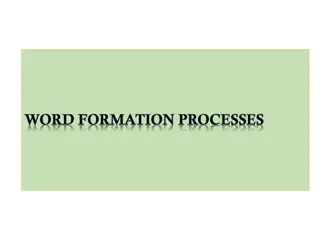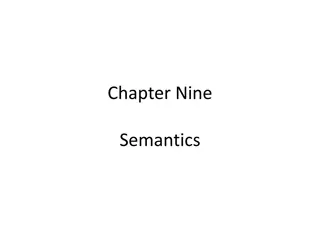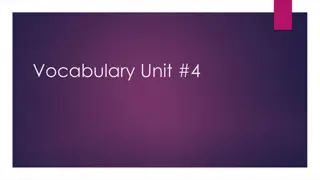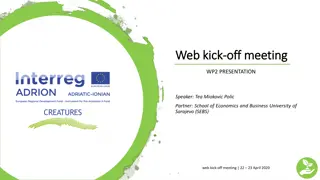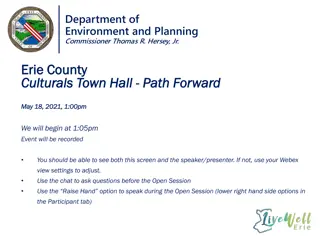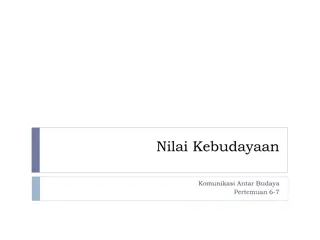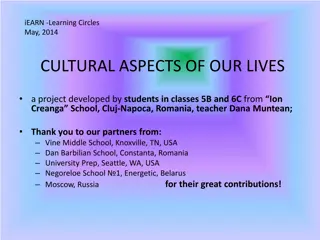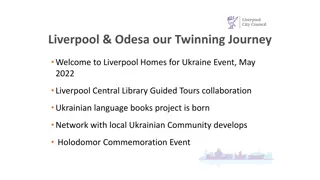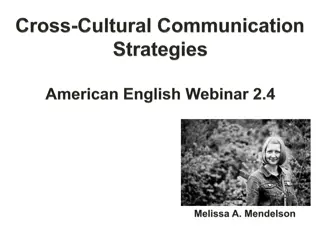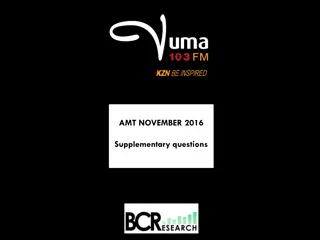Balti Cultural References and Words Explained
This text delves into various Balti cultural references and word meanings, exploring the significance of terms like "bat," "ka ik," "chon," "zan-zos" among others. It provides insights into the Balti language and culture, shedding light on elements like food, nature, relationships, and more.
Download Presentation

Please find below an Image/Link to download the presentation.
The content on the website is provided AS IS for your information and personal use only. It may not be sold, licensed, or shared on other websites without obtaining consent from the author. Download presentation by click this link. If you encounter any issues during the download, it is possible that the publisher has removed the file from their server.
E N D
Presentation Transcript
.. ( , . . ( , ). ). -
*a, > a: Balti bat boiled mixture of germinated grain flour and ordinary flour (made during Ramzan) (Sprigg 2002: 27). Cf. OIA bhakta- food; boiled rice , Khowar bot evening meal , Kalasha batay flour taken to be eaten in high pastures (Trail 1999), Shina bat, Bashkarik batt, Torwali b t, Kashmiri bat , Lahnda, Punjabi bhatt, Hindi-Urdu, Nepali, Gujarati, Marathi bh t boiled rice , Wakhi bat wheat flour gruel , Ishkashimi bat, Shughni b t, Munji b t k ritual food made of wheat flour and butter, cooked in water or milk . Balti basanda dandelion (Sprigg 2002: 27). Cf. OIA v santa- vernal, pertaining to spring , OIA vasanta-, Shina baz n, Phalura bas nd, Bashkarik basan, Torwali bas n, Kalasha b sun, Khowar bosun, Pashai wah n(d), Gawar-Bati wasand spring . Balti ka ik small branches (Sprigg 2002: 82), Ladakhi ka ik branches and leaves of trees as fodder for animals in the spring (Norman 2010: 4). Cf. Kati k t branch , Kalasha kat board (Trail 1999), Shina k t wood , Kashmiri k t h wood , k t h small stick , Lahnda, Punjabi, Hindi-Urdu, Kumauni, Nepali, Gujarati k t h, Sindhi k t h wood , .- . k s t ha- piece of wood , k s t hik - small piece of wood .
*a > o : Balti chon vain (Sprigg 2002: 43), Purik chon ( t hon ) useless, in vain, unfounded (Zemp 2018: 109), Ladakhi chon spontaneously, for no reason, gratuitously; in vain, for nothing, to no avail, useless; free, for free, at no cost (Norman 2010: 310). Cf. Burushaski c han (Hunza), c an (Yasin) leer (Sch ssel), unterbesch ftigt, ohne Arbeit, frei (Berger 1998: 106), Shina c hon, Phalura he iko, Bshkarik c han, Kashmiri hon, Gawar-Bati c h nika, Pashai (Kurangali dialect) h ni empty, void . Balti (Skardu dialect) dom sadness, trouble, difficulty, adversity (Norman 2010: 493). Cf. Shina da mizh r adversity, trouble (Bailey 1924), Burushaski d m(i)jar trouble, inconvenience, worry (Lorimer 1938). The Shina word is most probably the source for the Burushaski one, and may be related to OIA damayati tames, subdues , Ossetic domyn to tame; exhaust; demand . Balti tshon injury (Sprigg 2002: 171). Cf. OIA ks a oti injures, hurts , ks a ana-, injury, damage , Pali kha ati destroys , Khotanese vas anaurau destructive (Bailey 1979: 379) < *vi- ana-bara-, Greek I kill < PIE *tk'en-(LIV: 645).
*a , *i : Balti zan-zos, dzan-zos (Turtuk dialect), Purik zan-zos wife; family (Norman 2010: 842; Sprigg 2002: 180). Cf., e.g. Phalura jeeni female person (Liljegren, Haider 2011: 76), Kashmiri z n , Sindhi, Lahnda, Punjabi ja woman , Bashkarik jin kar- to marry , Indus Kohistani zh l marriage (Zoller 2005: 202), OIA jani-, Av. aini- woman, wife . The initial dz in Balti may point the initial affricate of the donor language. Balti basanda dandelion (Sprigg 2002: 27). Cf. OIA v santa- vernal, pertaining to spring , OIA vasanta-, Shina baz n, Phalura bas nd, Bashkarik basan, Torwali bas n, Kalasha b sun, Khowar bosun, Pashai wah n(d), Gawar-Bati wasand spring .
*r > i: Ladakhi kit-ces to catch, seize, capture (Norman 2010: 82). Cf. Bashkarik g t took, bought , Wo apuri gat took , Gawar-Bati g t m I took < *gr pta- < *gr b-ta- (Vedic gr bdha-, Avestan g r pta- taken ). *r > e * ?: Ladakhi shen-ces to squash (Norman 2010: 986). Cf. OIA r ti crushes, breaks , Khowar en k to crush . . i e .
- : Ladakhi kit-ces to catch, seize, capture (Norman 2010: 82). Cf. Bashkarik g t took, bought , Wo apuri gat took , Gawar-Bati g t m I took < *gr pta- < *gr b-ta- (Vedic gr bdha-, Avestan g r pta- taken ). Ladakhi pat, paddi, patsi totally, completely (Norman 2010: 533) < *bad. Cf. OIA baddha- bound , Gujarati b dhu whole, entire , West Pahari (Kotgarhi) baddh all, entire, (pl.) all together , Kashmiri bod handful . Ladakhi tul powdered dung (Norman 2010: 448) < *dul. Cf. OIA dh li- dust, powder , dh lik - pollen, fog, mist ; Prakrit dh l , Hindi dh l, Punjabi, Lahnda, Gujarati dh , Sindhi dh i, Kumauni dhuli, Bengali dhul, Marathi dh dust ; Nepali dhulo dust, powder ; Tirahi "d da", Kalasha udhru , Shina d , Phalura d i dust ; Pashai (Wegali dialect) du dust-storm ; Torwali dur mist .
*bh > b, *dh > d, *jh > j > (d)z: Balti bat boiled mixture of germinated grain flour and ordinary flour (made during Ramzan) (Sprigg 2002: 27). Cf. OIA bhakta- food; boiled rice , Khowar bot evening meal , Kalasha batay flour taken to be eaten in high pastures (Trail 1999), Shina bat, Bashkarik batt, Torwali b t, Kashmiri bat , Lahnda, Punjabi bhatt, Hindi-Urdu, Nepali, Gujarati, Marathi bh t boiled rice , Wakhi bat wheat flour gruel , Ishkashimi bat, Shughni b t, Munji b t k ritual food made of wheat flour and butter, cooked in water or milk . Ladakhi darak, Purik deraq stiff, hard (Norman 2010: 438) < PII *dh raka-. Cf. Kashmiri dor firm, hard, strong, compact, durable, solid , darun to become steady (of something in motion), to become firm, to stand steady (Grierson 1915-1932: 238, 246), Pashai d(h)ar-, Wotapuri dar-, Phalura dh ara- to remain, stay , Torwali d r they remained , Khowar dorik hold back, wait, keep , Hindi, Punjabi dharn to keep , Gujarati dharvu to hold, catch , OIA dh rayati, dharati holds, keeps , Avestan d raiiehi (you) hold . ?Ladakhi (Shamskat, Leh) zanggi a species of tiny flying biting insect (Norman 2010: 825). . . an- , ( ) < . *gan-/jan- , ; , = .- . han- ; ; ; ( , 2007: 136). , . *jhan-aka- *-in/- . a (*jhanaka- > *zang-) ( . g < * unaka-, s g < *samaka-).
* > c, *j(h) > dz > z: Ladakhi tsapik a little, a bit, a little while (Norman 2010: 731) < PII * ap- to catch, snatch, pick, pinch , cf. Shina ap-, Indus Kohistani cap-, Gawar-Bati cep- to bite , Pashai ip- to bite off , Kashmiri cop a bite , Balochi mp- to snatch , Ossetic c fsyn to stick, glue , Munji c b- to pluck . Balti zanzos, dzanzos (Turtuk dialect), Purik zanzos wife; family (Norman 2010: 842; Sprigg 2002: 180). Cf., e.g. Phalura jeeni female person (Liljegren, Haider 2011: 76), Kashmiri z n , Sindhi, Lahnda, Punjabi ja woman , Bashkarik jin kar- to marry , Indus Kohistani zh l marriage (Zoller 2005: 202), OIA jani-, Av. aini- woman, wife . Balti gzar to flow (Sprigg 2002: 72), Purik zar id., Ladakhi zar-ces, dzar-cas to drip, to run down, to trickle out (Norman 2010: 790). Cf. Av. ar- to flow , Ossetic z lyn to pour down, drip , OIA jhara- waterfall , jhar river , Prakrit jhara drips , Hindi jharn to ooze, trickle away < PII *gjhar- < PIE *dhgwher- (Cheung 2007: 124).
: Ladakhi cancil, chancil the green outer shell or fruit of walnut (Norman 2010: 267). Cf. Burushaski hanj l (Nagir, Hunza), anj l (Yasin) die gr ne ussere Schale der Walnuss, H utchen zwischen den Teilen des Walnusskerns , Shina ha il id. (Berger 1998: 96). Balti cangti drop , Purik, Ladakhi (Shamskat and Leh dialects) cangti leak in a roof (Norman 2010: 267). Cf. Burushaski han man-, ha han - (Wasser) sickern, herabfliessen (Berger 1998: 97). Balti cha millet (Sprigg 2002: 41), Ladakhi (Shamskat dialect) cha a variety of millet, a cereal grain which was grown in Ladakh in the past, but very little now (Norman 2010: 290). Cf. Burushaski ha (Nagir, Hunza), a (Yasin) Hirse, Kolbenhirse, Setaria italica (Berger 1998: 95).
: Balti be-kar court singer and dancer who improvises poems and songs (Sprigg 2002: 28), Ladakhi be- da member of the caste that used to be itinerant musicians , be-mo f. (Norman 2010: 640-641) < *b iya- < PII *w d(i)ya- music, musical instrument , cf. OIA v dya- musical instrument, music , v dyakara- musician , Hindi-Urdu b j music , Kashmiri waz- to sound (of bell, clock etc.) , Shina (Guresi) ba - to strike (of a gong etc.) , Ossetic wadyn flute, panpipe < *v d ni . Balti (Skardu dialect) spa taste, tasty (neutral), (sexual) enjoyment , Purik, Ladakhi (Nubra dialect) spa taste, flavour (Norman 2010: 542; Sprigg 2002: 159) < PII *sw da-. Cf. OIA sv da- taste , Iranian * w da- (> Persian v good taste , Balochi w d salt ), Shina isp vu tasty . Ladakhi perak Ladakhi women s head-dress, covered with turquoise and coral (Norman 2010: 539) < PII *paridh ka-. Cf. OIA paridh - to put on (clothes) , Hindi pahirn to put on, wear , Kashmiri p run to put on; to adorn, ornament , Khowar purduik to cover oneself, put on a cloak .
: Ladakhi shan i a leafy vegetable (Norman 2010: 975) < PII * ka- green vegetable . Cf. OIA ka-, Shina, Indus Kohistani , Phalura , Bashkarik a, Kashmiri h kh, Kalsha ak, Khowar ax, Waigali, Dameli c id., Indus Kohistani a green vegetable with round leaves (Zoller 2005: 378) < PIE *k ko- (Mayrhofer 1996: 628). Balti tshak rheumatism (Sprigg 2002: 169), Purik tshaq pain with difficulty of breathing , tshak yong to ache , Ladakhi tshak sprain, pulled muscle, sudden cramp, sudden sharp pain (Norman 2010: 759-760). Cf. OIA ks ata- wounded , ks ataka- wound . *t > d : Balti rindi lead, bullet (Sprigg 2002: 139), Ladakhi rindi bullet; lead (metal) (Norman 2010: 911) < *r di- < PII *r ti- Cf. Bashkarik r d, Torwali it ( < r) brass , Shina r l brass, bronze, copper , Gawar-Bati r t copper , OIA r ti- stream; yellow brass, bell-metal .
*k : Ladakhi kuruk donkey foal; foal (Norman 2010: 12) < *kurtaka-. Cf. Kalasha k a k (< *ku ak) child (male or female); the offspring of a human or animal (Trail 1999), Shumashti kur , Dameli kur a child , Ashkun k child, foetus , Kati kr u, kur uk young of animals , Prasun ky ru young of animals, child < *kurtaka-, Kurdish kurr son , Middle Persian kurrak, Persian kurra foal < *kurna(ka)-. Balti kulak meal (quickly made mixture of buttermilk and flour) (Sprigg 2002: 94), Purik kholak a certain dish , Ladakhi (Leh, Shamskat and Nubra dialects) kholak, qholak ready-to-eat dough of roasted flour (Norman 2010: 117). Cf. Burushaski (d)-q(h)ul-an- (Hunza, Nagir), d- ul-an- (Yasin) (Teig) kneten (Berger 1998: 357). Balti mulak, Purik mulaq turnip (Sprigg 2002: 118; Zemp 2018: 944). Cf. Burushaski m lo, Shina mu lo id., OIA m la- root , m laka- radish , Shina m l , Khowar m l root , Pashai m luk, Hindi-Urdu m l radish . Balti, Purik, Ladakhi multuk, mul uk fist (Norman 2010: 705; Sprigg 2002: 118). Cf. OIA mus t i-, Av. mu ti-, Khotanese mus t u, Sindhi mut hi, Lahnda, Punjabi mut t h, Hindi-Urdu, Gujarati, Marathi m t h, Nepali mut hi, Persian mo t, Shughni mut, Wakhi m st, Shina mut (h), Kashmiri mo t h, Phalura, Kalasha, Khowar mus t i, Gawar-Bati mus t k, Burushaski (loanword) mu fist .
s : Balti basanda dandelion (Sprigg 2002: 27). Cf. OIA v santa- vernal, pertaining to spring , OIA vasanta-, Old Persian -v hara-, Persian bah r, Shina baz n, Phalura bas nd, Bashkarik basan, Torwali bas n, Kalasha b sun, Khowar bosun, Pashai wah n(d), Gawar-Bati wasand spring .
* (< .-. *k): Balti shang wisdom, sense (Sprigg 2002: 151), Purik a consciousness (Zemp 2018: 931), Ladakhi shang alertness, awareness, caution, prudence (Norman 2010: 553). Cf. Burushaski (loanword) awake, aware; care, heed, attention (Lorimer 1938: 322), Shina o n care, anxiety; awake, alert (Bailey 1924), Khowar an g fear, suspicion (Morgenstierne 1973), OIA an kate is afraid, distrusts , an k - fear, distrust < PIE *k enk-/*k onk- schwanken (Pokorny 1959: 566). Ladakhi shan i a leafy vegetable (Norman 2010: 975) < PII * ka- green vegetable . Cf. OIA ka-, Shina, Indus Kohistani , Phalura , Bashkarik a, Kashmiri h kh, Kalsha ak, Khowar ax, Waigali, Dameli c id., Indus Kohistani a green vegetable with round leaves (Zoller 2005: 378) < PIE *k ko- (Mayrhofer 1996: 628). ?Balti lashi a resinous wood used as a candle or torch because it burns slowly (Sprigg 2002: 98). Cf. Kashmiri la shi a torch (Grierson 1915-1932: 533), Shina (Gilgit dialect) la i torch (unlit) (i < * ). * (< .- . *k ) : Ladakhi po-ze ram, full-grown male sheep (Norman 2010: 540) < PII *pa u- cattle (> OIA pa u-, Avestan pasu- id., Pashto ps , Ossetic f s sheep ). Cf. also Pashai pa wala, Khowar pa l, Shina pa y l , Bashkarik pay l, Kashmiri puhul shepherd , Indus Kohistani p y l, OIA pa up la- herdsman .
. * > s > y : Balti m yu, myo mouse (Sprigg 2002: 119). Cf. OIA m s -, m s -, m s ika- mouse, rat , Persian m , Pashto m ak, Ossetic myst, Pashai m , Shumashti m s o, Gawar-Bati mus a, Torwali m s , Phalura mu s o mouse , Bashkarik m s mouse, rat , Shina (Guresi dialect) m rat , m ai mouse , West Pahari (Jaunsari) m , Romany mu mouse , Kumauni, Nepali muso mouse, rat . . * (> s ) > : Balti munzhur small mole-like mouse (Sprigg 2002: 119).
*w > b: Balti basanda dandelion (Sprigg 2002: 27). Cf. OIA v santa- vernal, pertaining to spring , OIA vasanta-, Shina baz n, Phalura bas nd, Bashkarik basan, Torwali bas n, Kalasha b sun, Khowar bosun, Pashai wah n(d), Gawar-Bati wasand spring . Balti be-kar court singer and dancer who improvises poems and songs (Sprigg 2002: 28), Ladakhi be-da member of the caste that used to be itinerant musicians , be-mo f. (Norman 2010: 640-641) < *b iya- < PII *w d(i)ya- music, musical instrument , cf. OIA v dya- musical instrument, music , v dyakara- musician , v dayati plays a musical instrument , Punjabi vajj musical instrument , Hindi-Urdu b j music , Kashmiri waz- to sound (of bell, clock etc.) , w y- to play a musical instrument , Shina (Guresi) ba - to strike (of a gong etc.) , Ossetic wadyn flute, panpipe < *v d ni .
*dw > b: Balti bar-ban window (in a wall), glass-pane window (Sprigg 2002: 26), Purik barban window (Zemp 2018: 945). Cf. Brokskat barban id.). Pashai dar , Gwawr-Bati der , Kalasha dur k, Phalura dar i, Indus Kohistani d r , Shina dari , Kashmiri d r window , OIA dv r- door, gate , Av. duuar- gate .
. *gjh : Balti gzar to flow (Sprigg 2002: 72), Purik zar id., Ladakhi zar-ces, dzar- cas to drip, to run down, to trickle out (Norman 2010: 790). Cf. Av. ar- to flow , Ossetic z lyn to pour down, drip , OIA jhara- waterfall , jhar river , Prakrit jhara drips , Hindi jharn to ooze, trickle away < PII *gjhar- < PIE *dhgwher- (Cheung 2007: 124).
. *k (> .-. ks, . *x, . *h) > h Balti, Purik chal overflow, spill over , Ladakhi (Leh and Shamskat dialects) chal-ces to splash, to spill over (Sprigg 2002: 41; Norman 2010: 297). Cf. OIA ks arati, ks alati flows, trickles , ks layati washes , Proto-Iranian *x ar- to flow (> Persian r dan to trickle , ( b) r waterfall , Ossetic xs rdz n waterfall (< *x ar- ana-), Middle Persian X art the river Jaxartes (Livshits 2003)), Kashmiri halun to wash , har a sprinkle of water etc. from the fingers ), Gawar-Bati c h r rapids in a stream , Phalura, Indus Kohistani c h r, Bashkarik, Kalasha uc h r, Shina c har waterfall .
*kt, *pt > t: Balti bat boiled mixture of germinated grain flour and ordinary flour (made during Ramzan) (Sprigg 2002: 27). Cf. OIA bhakta- food; boiled rice , Khowar bot evening meal , Kalasha batay flour taken to be eaten in high pastures (Trail 1999), Shina bat, Bashkarik batt, Torwali b t, Kashmiri bat , Lahnda, Punjabi bhatt, Hindi-Urdu, Nepali, Gujarati, Marathi bh t boiled rice , Wakhi bat wheat flour gruel , Ishkashimi bat, Shughni b t, Munji b t k ritual food made of wheat flour and butter, cooked in water or milk . Ladakhi kit-ces to catch, seize, capture (Norman 2010: 82). Cf. Bashkarik g t took, bought , Wo apuri gat took , Gawar-Bati g t m I took < *gr pta- < *gr b-ta- (Vedic gr bdha-, Avestan g r pta- taken ).
*nk > ng: Balti shang wisdom, sense (Sprigg 2002: 151), Purik a consciousness (Zemp 2018: 931), Ladakhi shang alertness, awareness, caution, prudence (Norman 2010: 553). Cf. Burushaski (loanword) awake, aware; care, heed, attention (Lorimer 1938: 322), Shina o n care, anxiety; awake, alert (Bailey 1924), Khowar an g fear, suspicion (Morgenstierne 1973), OIA an kate is afraid, distrusts , an k - fear, distrust . *ngh > g > k, q: Ladakhi tak-tak (Shamskat dialect), ak- ak, (Leh dialect) taut, stretched tight, tight (e.g. of curtain, clothing, greenhouse plastic) , Purik taqtaq tight (Norman 2010: 370), Balti ak- ak hard (Sprigg 2002: 184) < *tag < PII *tangh- (> Proto-Iranian * anj- to pull, draw ( > Avestan a j- id., Persian sanj dan to measure; reflect; compare, put in balance , Ossetic t n n to spread, stretch out; to crucify ), Kashmiri t anz extreme and urgent desire , Khowar tonjeik to destroy, pull down ).
*rt (> *r) > r: Ladakhi kuruk donkey foal; foal (Norman 2010: 12) < *kurtaka-. Cf. Kalasha k a k (< *ku ak) child (male or female); the offspring of a human or animal (Trail 1999), Shumashti kur , Dameli kur a child , Ashkun k child, foetus , Kati kr u, kur uk young of animals , Prasun ky ru young of animals, child < *kurtaka-, Kurdish kurr son , Middle Persian kurrak, Persian kurra foal < *kurna(ka)-. *rth > , , t?: Balti, Purik ga knot, joint of body (Sprigg 2002: 58; Zemp 2018: 64), Ladakhi (Leh dialect) changgat knee-joint (Norman 2010: 313), gat obstacle (Norman 2010: 241) < *garthi-? Cf. OIA granthi- knot , granthayati ties , Hindi, Bengali, Marathi, Gujarati g t h, Punjabi, Lahnda ga d h, Sindhi g'a d hi, Middle Persian grih, Persian girih, Khotanese grratha, Soghdian r n , Ishkashimi urex , Ossetic lxync', Kalasha, Phalura grh d , Indus Kohistani g r , Brokskat gat hi knot , Pashai gat an joint , gat h- to tie , Burushaski gat Knoten (auch im Stengel von Pflanzen), Kn chel (des Fingers) (Berger 1998: 150). *r *rt : Balti rkat to cut down with a sword (Sprigg 2002: 140). Cf. PII *kart- to cut > OIA kr ntati, kartati cuts , Av. k r taiti cuts , kar ta- knife , Hindi-Urdu katt curved knife , katt sword, knife, dagger , Tirahi kat ri knife , Pashai k t are spear , Gawar-Bati kat ro large knife , Kalasha kat r, Khowar kuter knife, dagger , Bashkarik k t er knife , Savi kat r i, Phalura kat ro dagger , Shina kha t a r knife .
*sc (< .-. *sk') > (*h?) > ch: Ladakhi tshele thatched roof, shade made of branches and leaves, thatched- roofed house or hut (Norman 2010: 773), Balti tshele hut (Sprigg 2002: 170) < PII *s ad-ila-. Cf. Kashmiri che y a kind of thatching grass (Grierson 1915-1932: 1066), Lahnda, Punjabi chatt, Hindi chat roof , OIA ch dayati covers , chadis- cover, roof , Proto-Iranian *s d- to cover (cf. Pashto to adorn < *upa- or *pati-s d-) < PIE *sk ed-.
*sw > sp: Balti (Skardu dialect) spa taste, tasty (neutral), (sexual) enjoyment , Purik, Ladakhi (Nubra dialect) spa taste, flavour (Norman 2010: 542; Sprigg 2002: 159) < PII * sw da-. Cf. OIA sv da- taste , Iranian * w da- (> Persian v good taste , Balochi w d salt ), Shina isp vu tasty .
*r > s (> ): Ladakhi shen (Leh dialect), s en (Shamskat dialect) (wooden) floor (Norman 2010: 986) < PII * rayana- leaning, foothold (< * ri- to lean , cf. OIA ri-, Avestan sri- id.). Cf. Sinhalese hi i, Hindi-Urdu, Punjabi s h , Phalura i, Pashai s ur , Shumashti s nd , Gawar-Bati sid , Yidgha x ad, Pashto s l ladder, stair .
*t > s > l (> lt): Balti, Purik, Ladakhi multuk, mul uk fist (Norman 2010: 705; Sprigg 2002: 118). Cf. OIA mus t i-, Av. mu ti-, Khotanese mus t u, Sindhi mut hi, Lahnda, Punjabi mut t h, Hindi-Urdu, Gujarati, Marathi m t h, Nepali mut hi, Persian mo t, Shughni mut, Wakhi m st, Shina mut (h), Kashmiri mo t h, Phalura, Kalasha, Khowar mus t i, Gawar-Bati mus t k, Burushaski (loanword) mu fist .
--, -- = .-. -sh-: Balti ka ik small branches (Sprigg 2002: 82), Ladakhi ka ik branches and leaves of trees as fodder for animals in the spring (Norman 2010: 4). Cf. Kati k t branch , Kalasha kat board (Trail 1999), Shina k t wood , Kashmiri k t h wood , k t h small stick , Lahnda, Punjabi, Hindi-Urdu, Kumauni, Nepali, Gujarati k t h, Sindhi k t h wood , .- . k s t ha- piece of wood , k s t hik - small piece of wood . .- . k s t ha- < .- . *kol-s- tho- (Klima 1970; Burrow 1975), . .- . *kel - schlagen, hauen (Pokorny 1959: 545- 547). -t ha- , , .- . -th -, . - - ( . .- . artha- , , Av. ar a- , , OIA g th -, Av. g - ).
.-. *tk (> .-. ks, . *) > ch: Balti tshon injury (Sprigg 2002: 171), Balti tshak rheumatism (Sprigg 2002: 169), Purik tshaq pain with difficulty of breathing , tshak yong to ache , Ladakhi tshak sprain, pulled muscle, sudden cramp, sudden sharp pain (Norman 2010: 759-760). Cf. OIA ks a oti injures, hurts , ks ata- wounded , ks ataka- wound , ks a ana-, ks ati- injury, damage , Pali kha ati destroys , Khowar ay illness (= OIA ks ati-?), Khotanese vas anaurau destructive (Bailey 1979: 379) < *vi- ana-bara-, Manichaean Soghdian p yyn 3 Sg to trap < *apa- or *upa- an-, Christian Soghdian pt ng, Buddhist Soghdian pt nkh cross, torture-instrument < *pati- ana-ka- (Gershevitch 1954: 25, 96) Greek I kill < PIE *tk'en-(LIV: 645).



